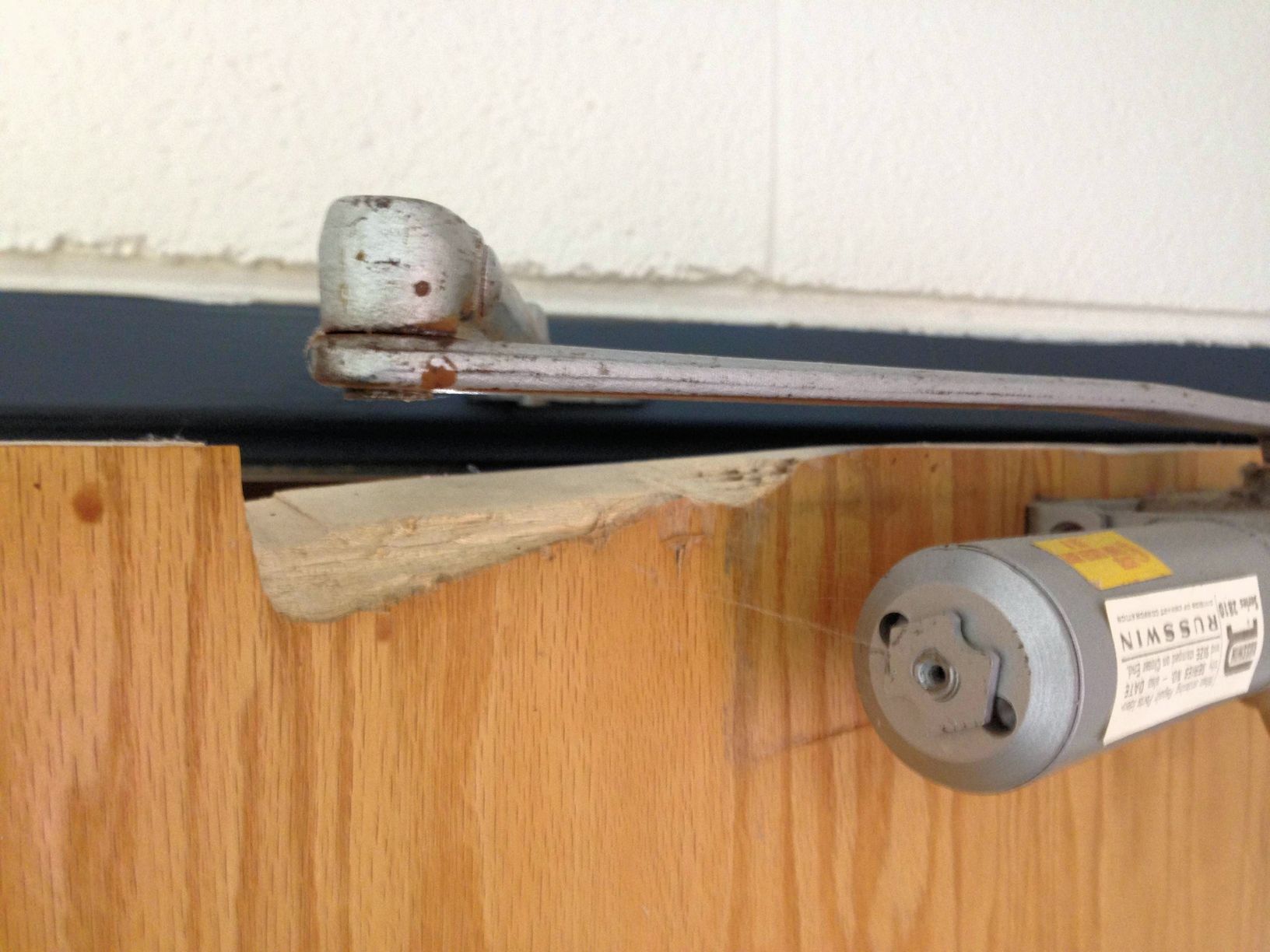Here’s a little Fixed-it Friday quiz…what should have been done to avoid the need for this field modification?
Photo sent by Scott Barringer of Allegion…special application seen while surveying a school to identify existing problems and suggest solutions. We can help your facility with this too! (Email me if you’re not sure who to contact.)
You need to login or register to bookmark/favorite this content.







Buy shorter doors
Mount the closer on the right side of the door…..
Assuming the arm is installed and adjusted properly, then the arm attaching screw must be loose, allowing the arm to drop as it opens and closes.
If it had to be mounted on the pull side a Top Jamb Mount with TJ plate if needed or Parallel mount on push side would be a better choice…..Lastly use LCN ….:P
for this, make sure the arm is NOT bent and pelase, (one of my pet peeves with closers) INSTALL and tighten the arm screw that holds closer’s arm to the pinion shaft,
this pic it looks like a severe case of loose or bent arm hitting the top of the door,
looks like something my friend in HK would show me
if arm is not bent and the screw is tight, it may be the arm is not th eone supplied with the closer body, (some closers the pinion shaft is higher then the arm thickness at the star punch ( many knockoff brands are like that)
looks like this one is NOT following the one of the 4 L’s of door closers, which are:
1. checking for LEAKS
2.tighten LOOSE screws (body mounts, arm to frame mounts and arm screw!)
3, LUBRICATE hinges and “elbow” and “wrist” joints of closer arm
make sure its LEVEL, a closer’s internal rack and pinion mechanism is desgiend to work best when the closer is mounted level on the door (or in the floor if its a floor closer) a closer that is NOT level can wear out prematurely at the pinion shaft needle bearings/seals, and the “elbow” and “wrist joints of the arm, as well as not be as efficient in closing the door effectively compared to one that is mounted level (the proper way)
in floor closers, one that is not level can cause premature wear in the spindle shaft bearings/seals of the closer and the top pivot as well as can cause loss of control due to how the hydraulics are set up inside the unit (if at a steep angle, door may slam instead of have dampening during sweep and latch ranges of closing
-Jess the door closer doctor
Luckily this wasn’t an LCN problem (being a Corbin Russwin closer haha). Looks as though this is a narrow face frame (not 2″). If they had installed per the instructions the arm wouldn’t interfere with the top of the door (closer bracket on frame face should be at least 7/8″ up from the stop to centerline, this bracket appears to be almost mounted at the stop). Looks as though the regular arm installation fell to vandalism as well seeing the bend in the arm.
The door closer may be too low on the door to allow the arm to clear the top of the door, but if the closer was any higher, the sex nuts would interfere with the frame stop. The arm appears to have a “mid-span custom bend”. Is the closer not installed straight? At the far right side of the picture, near the edges, it appears there isn’t enough lift on the arm to clear the door. Looks like a “low overhead” arm. Not sure if this manufacturer commonly supplied arms with low lift. Another cause, as Nelson commented, is the pinion screw being loose and the arm ‘drooping’ as the door is opened or closed. A new arm with greater lift would definitely be my vote.
I installed many of that exact model closer for over twenty-five years. As Nelson said, the screw that fastens the arm to the closer spindle may be loose, but I’m betting that the screws that attach the closer mounting plate to the door are loose (or, the screws may be stripped in the door if they foolishly used the wood screws instead of sex bolts).
When those screws are not properly fastened, the closer will rock, tipping the spindle towards the top of the door, allowing the arm to drop and rub on the top of the door.
Many people don’t bother to check those screws, because you have to remove the heavy, cast iron closer from the mounting plate to access them.
And on a second look I just noticed that the arm shoe is mounted a little too low on the buck.
We specify push side mount only with EDA (extra duty arm) closers. Students love to use a regular arm mounted on the pull side as a chin up bar.
It’s a little hard to tell from the picture whether this “field modification” was done intentionally or evolved over time.
The closer may have also been mounted too low for the arm clearance, but the angle of the cut suggests a bent arm.
Hire a professional?